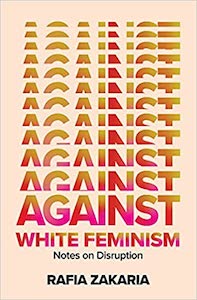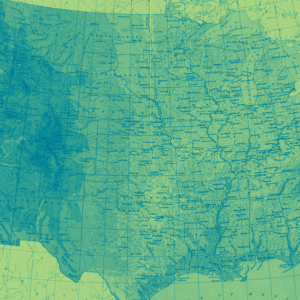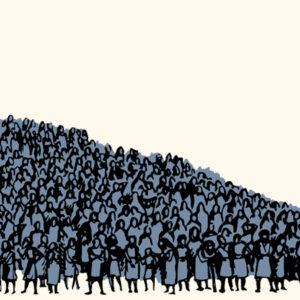
How the War On Terror Became America’s First “Feminist” War
Rafia Zakaria on American Neoimperialism Lies of Liberation
“I’m fine,” the pale, red-haired Jessica Chastain says as she takes off her full black jumpsuit and face mask. The scene is from Kathryn Bigelow’s 2012 film Zero Dark Thirty, which despite the seeming banality of the dialogue, says a lot about a new flavor of feminism that has evolved in the white and Western world since 9/11 and the War on Terror. In the film, Chastain plays a CIA “targeter” named Maya who is physically delicate but tough as nails in every other way, which in this particular conversation also means that she is up for torture. In fact, that is what she and her male CIA colleague have been doing inside a makeshift bunker that also serves as a torture chamber. “Let’s go back in there,” she tells the men after they have rested a minute from the hard toils of inflicting extreme pain on other human beings.
Here, then, is gender equality at its most perverse, a white woman trying her best to show a white man that she has as much of an appetite for cruelty as he does. And the laconic white men appear to approve. “She’s a killer,” her boss says in her wake as she disappears down a hallway. If this had been an entirely fictional film, all of it could have been discarded as the morbid fantasy of some Hollywood director. As it happens, Maya is based on a very real CIA sleuth, whose identity the agency has never released but to whose gritty greatness many have made pointed allusions. Maya (along with others, also mostly women, CIA sources have said) was responsible for the capture and killing of Osama bin Laden in May 2011.
The film Zero Dark Thirty may be a souped-up, cinematically slick, and action-packed retelling of what the real Maya managed to do, but it is based on fact. For her now-feted heroism, the real Maya won the Distinguished Intelligence Medal, an honor about which she was happy to boast to all her CIA colleagues through a mass email.
I watched Zero Dark Thirty in a nearly full movie theater in Indiana. Jessica Chastain’s Maya may have been “fine” in makeshift torture bunkers, but I definitely was not. Beyond the movie theater, the shopping mall was all aglow with holiday decorations and around me, my fellow moviegoers seemed snug in the cozy darkness of the theater and smug in this elevation of white women as the ultimate weapon in crushing Brown terrorists.
The crowd repeatedly cheered, once during a scene that showed a Brown man being waterboarded, another time as Chastain’s Maya inched closer to catching the man whom the Americans had been hunting for a long decade, and of course at the end as she is hailed as the heroine who crushed the most evil man in the world. The whole exercise was an elaborate revisiting of glory designed to puff the chests of patriots. The end of the film was never a mystery, America had won, and at least for the purposes of the film, a slight, flame-haired, delicate-featured “killer” had sleuthed and tortured her way to ensuring the obliteration of the most wanted Brown man in the whole world.
I cringed, not just because Maya’s search for parity with men extends to trash-talking and torture, or even because she calls Pakistan “a really fucked-up place” within the first few minutes of the film, but because it seemed that I was the only person who saw in Zero Dark Thirty an utter perversion of the general project of gender equality. I cried at the end, because the audience stood up to hand the movie a standing ovation. A few months later, the movie was further regaled at the Oscars. Jessica Chastain won Best Actress. The real and the fictive white women had prevailed, become equal to white men in their capacity to subjugate Brown men.
In Zero Dark Thirty (and the trueish story behind it), American feminism—once a movement that existed in opposition to the state, as a critique of its institutions and mores—was recast as one that served the state’s interests through any means imaginable. This identification with state interests, and the idea of going out to conquer the world with the same mindset of subjugation and domination possessed by white men, seems to have become a warped feminist goal. Put another way, white women wanted parity with white men at any cost, including by avidly taking on the domination of Black and Brown people. As white feminists have progressed within their societies and begun to occupy increasingly important positions, they are constructing a feminism that uses the lives of Black and Brown people as arenas in which they can prove their credentials to white men.
They are constructing a feminism that uses the lives of Black and Brown people as arenas in which they can prove their credentials to white men.
In her 2019 book A Woman’s Place: US Counterterrorism Since 9/11, Joana Cook writes that feminism, particularly in relation to the state, used to be focused on promoting peace and nonviolence. Being a feminist used to entail a sense of sisterhood with all women, discouraging actions where one woman hurt the life and livelihood of other women. The state was understood as propagating and institutionalizing patriarchal norms, and resisting those (rather than adopting them) was considered a feminist act. But in America’s War on Terror, the state had subsumed the struggle for equality within itself, giving white women seeming parity with white men in the opportunity to crush Brown, Muslim men, who had become the ultimate antagonist in the white imagination.
Crucially, these white women are allowed to take on the “unfeminine” characteristics of violence and warfare, which would typically threaten the dominant patriarchy they exist under, but only when they exercise this power over someone even lower than them in the white-supremacist hierarchy—that is, on Brown foreigners. Clearly visible in this trade-off is the kind of conditional, limited power that wealthy, 19th-century British women experienced when they ventured overseas to British colonies. In both cases, freedom is a zero-sum game, more for one group (white women) only possible as the reinforcement of less for another (non-white people). It is not just the notion of women being violent that is shocking and antifeminist but the racial dimension that is central to this assumption of greater power by white women.
If white American feminists of the 1960s and the Vietnam era advocated for an end to war, the new American feminists of the newborn 21st century were all about fighting in the war alongside the boys. Warfare, traditionally one of the most starkly gendered activities in human society, was opening its arms to women in even its most gruesome and violent moments, and this was seen as a great step forward for everyone. The War on Terror, at least in theory, was America’s first “feminist” war. It wasn’t just CIA analysts who were glorified, it was also female soldiers. The story of Pvt. Jessica Lynch is another example. On March 23, 2003, Lynch, a 19-year-old truck driver with a maintenance unit of the US Army, was caught in an ambush and captured by Iraqi forces. Eight other soldiers were killed, and Lynch was taken to a hospital, where, according to the Pentagon, she was mistreated by the Iraqis. The US Special Forces launched a secret mission to rescue Lynch; it was alleged that the first words she said when she was found were “I am an American soldier too.”
The rescue was recorded and a five-minute video was released to the media by the Pentagon. Within hours she became a media heroine, her courage was feted all over the news, she appeared on the cover of Newsweek against a giant American flag, and she was called a “female Rambo” and an “American hero.” It was much later that the heroics of Lynch began to be questioned. The BBC aired a scathing documentary that accused the US government of exaggerating the heroics of her rescue and mistreatment by the Iraqis to bolster public support for the war. Many of these allegations were later proven to be true, but the hero-making the Pentagon set out to do in the immediate aftermath of the rescue was already in play. The female American soldier as heroine in the Iraq war was the image Americans would remember. It was notable that the television film Saving Jessica Lynch, aired on NBC in 2003, told the same heroic story that had been challenged by the BBC and others. America wanted a soldier-heroine, and they got one.
I also refer to the war as “feminist” because the propagation of women’s rights was front and center as an actual goal. American women were liberated, and now they, along with male service members, would go to Afghanistan to root out the misogynist regime of the Taliban. America, thus, was not a cruel superpower bombing a small and hapless nation but a force for good that would actually help bring gender equality to a war-torn country. The effort to eradicate terror (read: Islamic terror, not white nationalist terror, despite the latter’s considerably larger tally of dead Americans) was one of providing schools and health clinics and even beauty parlors, assisting in legal reform and the development of domestic-violence shelters, drafting progressive constitutions. The small matter of devastating bombings that left thousands dead and more disabled, forever splintered families, and wrecked livelihoods was a necessary means to that shining feminist end. When a white American woman (such as Chastain’s Maya in Zero Dark Thirty) did something unimaginably violent or cruel, it was part of the larger noble project of helping Afghanistan or Iraq become countries that valued women just as America valued them.
The War on Terror, at least in theory, was America’s first “feminist” war.
To fulfill the women’s liberation portion of the War on Terror, there were efforts to create Yemeni and Iraqi and Afghan “Mayas”—women trained in warfare drawn from behind enemy lines and reconstituted as double agents, something unusual if not unprecedented in the Middle East and South Asia. Millions of dollars were spent on counterterrorism training for women, including at least one elite all-female Yemeni counterterrorism unit and two programs, Sisters of Iraq and Daughters of Fallujah (designed to provide incriminating information on the Brothers of Iraq and the Sons of Fallujah, respectively). These programs were based on the premise that Brown women could be weaponized against the Brown men who were their family and friends—that their intrinsic identification with and loyalty to a Western definition of freedom and feminism would supersede their bonds to their communities. But the irony that some Americans could be bombing one village in the morning while other Americans inaugurated a school in another in the afternoon could not pass unnoticed by Afghan women, on whom the interests and aspirations of white American feminists were inscribed.
The point here is not so much that the Countering Violent Extremism (CVE) programs (the new branding given to anti-terror programs) were a failure but rather the smug white feminist assumption that Afghan women were so disconnected from their fathers, brothers, and husbands (all cruel and barbaric in the American imagination) that they would be happy to serve as spies and intelligence gatherers for the Americans. It is this failure, or refusal, to recognize that Afghan women were inextricably connected to Afghan men, and that bombing the men directly affected the women, that explains the failure of many programs initiated in the region.
The entanglement of the “liberating women” agenda with America’s endless and ever-expanding War on Terror gave birth to “securo-feminism,” a term described by the scholar Lila Abu-Lughod to indicate the collusion between international women’s rights advocates and the global security enterprise referred to as CVE. Securo-feminism holds that fighting against terrorism is in itself a kind of feminism. The national shock and grief around the 9/11 attack located this foreign war in a very different category from any that America had fought before. The threat was not abstract or hypothetical, and it was not happening somewhere far away. It felt tangible, immediate, personal.
In his book Bland Fanatics, the author and historian Pankaj Mishra recounts just how readily the War on Terror and all of its incipient brutalities were accepted even by the intellectual class, which had traditionally been critical of America’s military adventures in the developing world. The particular neo-imperialist flavor of the moment was captured in a bit of triumphal reporting by the Atlantic’s Robert Kaplan, who gleefully wrote that “Welcome to Injun Country” was the refrain among American soldiers all over the world, who imagined that their mission was playing cowboy to kill and dominate darker-skinned enemies by any possible means.
But the task of saving Afghan women could put a shinier gloss on the job. As the anthropologist Lila AbuLughod points out in her book Do Muslim Women Need Saving?, Americans promoted a “liberation lie” that positioned them as the saviors of downtrodden Afghan women. From this superior perch, white liberal feminists imagined gender-based violence as something found only in faraway lands. Among public commentators and journalists, the “liberation lie” facilitated blindness about both US foreign policy and the problems women face in the developing world.
In 2002, a coalition of Western women’s organizations sent an open letter to President George W. Bush, asking him to “take emergency action to save the lives and secure the future of Afghan women.” Its signatories included Eleanor Smeal, president of the Feminist Majority Foundation in Virginia, together with other notable feminists such as Gloria Steinem, Eve Ensler, Meryl Streep, and Susan Sarandon. US women overwhelmingly support the war, they noted, because it will “liberate Afghan women from abuse and oppression.” The National Organization of Women (NOW) put out statements in support of the war and its allegedly “feminist” objectives. Everyone in the mainstream American and British establishment, including white feminist heroines like eventual Secretary of State Hillary Clinton and Secretary of State Madeleine Albright, signed on wholeheartedly to the cause of fighting the War on Terror via any means that the military, the CIA, or the president thought necessary. The disconnect between the practice of American brutality and preaching of American saviordom managed to escape notice.
In July 2004, three years into the invasion of Afghanistan, Bush announced victory: “Three years ago, the smallest displays of joy were outlawed. Women were beaten for wearing brightly colored shoes. Today, we witness the rebirth of a vibrant Afghan culture.” More recently, a New York Times headline tried to celebrate victory even while noting that women themselves had a different experience: “Shelters Have Saved Countless Afghan Women, Then Why Are They Scared?” The article did not note that the “countless” were a fraction of the 32,000 civilians that Americans and Western forces had killed during the occupation.
Thus, a new flavor of white American feminism was born. Bolstered by the history of white supremacy within feminism, it resurrected nationalistic themes and made the international propagation of feminist values, such as gender equality, a necessary component of American feminism itself. Securo-feminism, a term coined by Columbia scholar Lila Abu-Lughod, stands for the collusion between countering violent extremism (CVE) initiatives and global gender rights advocacy. Securo-feminists were not simply invested in fighting the War on Terror, they were also committed to using American military power to promote American values all over the world. Just as imperial feminists during the British colonial era had convinced themselves of their own benevolence in improving the lives of native women, so too did securo-feminists believe that they were “saving” Afghanis and Iraqis from themselves.
The birth of securo-feminism was not an accident or a coincidence. The Bush administration’s discourse on the Global War on Terror propagated the notion that belief in women’s dignity and women’s equality required support for the War on Terror. Yet the history of racial privilege that made white women so comfortable in claiming moral authority and in exercising power over Brown men went largely unexamined.
Securo-feminism, thus, bound white American feminism to the neoimperial and neoliberal project of nation-building around the world.
When Iraq became the second venue after Afghanistan for the great American experiment in democracy promotion, it became necessary to establish securo-feminists there too. As President Bush put it, Iraqi women had to have rights because “the security of our own citizens depends on it.” The continuing American march to “advance of freedom in the Greater Middle East,” Bush claimed, has “given new rights and new hopes to Iraqi women” who would “play an essential part in rebuilding the nation.” Upholding “women’s dignity” was, in this view, directly linked to fighting terrorism since “men and women with dignity do not strap bombs to their bodies and kill innocent people.” American values respected women’s right to equality, and so the imposition of American values was crucial to getting people in these lesser states to learn to respect women’s rights. There was, in the grammar of the War on Terror, only one way to get to gender parity, and it was in the establishment of American-style liberal democratic institutions.
Securo-feminism, thus, bound white American feminism to the neoimperial and neoliberal project of nation-building around the world—one that Harvard professor and historian Niall Ferguson had articulated in his theory of “Anglobalization,” proposing that young Americans should be taught to go overseas and transform other nations in their own image much as Britain had done. Caught in its fevers, American feminists did not question loudly enough the wisdom of exporting feminism through bombs and drones. Trickle-down feminism, everyone assumed, would miraculously fast-forward the realization of a gender-equal, free-market world created in the self-image of America.
In 2012, securo-feminism gained even more clout by becoming the basis upon which the United States would engage with other women around the world. In the words of Jane Mosbacher Morris, who drafted the first “US Women and Counter-terrorism” strategy and the US Counter-terrorism Department’s plan on Women, Peace, and Security, “We really started to solidify what the different ways are in which you can engage women on the issues of terrorism and counter-terrorism and what as a department we can be doing to get women to engage.” The new plan wanted women in countries involved in the War on Terror to engage in “counter-messaging and other examples of the fight against terror.”
A 2016 report by the US Institute for Peace (USIP) declared, “Women’s rights and place in society are central to the narratives of violent extremist groups, and these narratives are the terrain on which women in Afghanistan fight to establish their rights.” The argument being that since terror groups wanted to limit women’s rights, women should be enlisted in fighting them. Feminism thus was fighting terrorism. Notably this meant only that “Countering Violent Extremism (CVE) and Preventing Violent Extreme (PVE) needs to include women as target groups.” Notably, there was no mention of investing in Afghan women’s political participation, perhaps because if Afghan women had political freedom they would prioritize ending the American occupation over anything else. Instead, the goal was to train Afghan women to be puppets that would parrot whatever their American CVE or PVE instructors taught them.
In the paradigm set out by this strategy, if women were unwilling to accept the American assumption that most of their young men were terrorists, and to collaborate with American forces in interrogating, imprisoning, or killing them, then it must be assumed they were also against women’s empowerment. In this way, supporting America’s foreign-policy interests had become synonymous with feminism.
__________________________________

Excerpted from Against White Feminism: Notes on Disruption. Used with permission of the publisher, W. W. Norton & Company, Inc. All rights reserved. Copyright © 2021 by Rafia Zakaria.
Rafia Zakaria
Rafia Zakaria is the author most recently of Against White Feminism (Norton 2021) She is the winner of 2024 Pushcart Prize for Best Essay “The Crows of Karachi” published in Orion Magazine.












